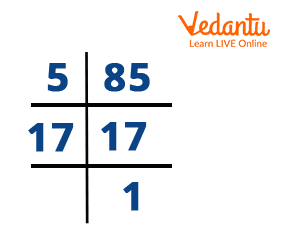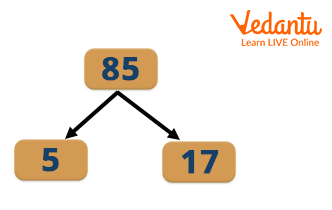




Factors: An Introduction
A factor is a number that completely divides the original number. Real numbers that can evenly divide the number 85 are factors of
Let's use straightforward methods in this article to determine the factors, pair factors, and prime factors of
What is the Factor of
The natural numbers that can divide a number 85 evenly are factors of
We can determine the other factors of

Factor of 85
How to Find Factors of
The natural numbers that can divide a number 85 evenly are factors of
When the product of two natural numbers results in
Therefore, the factors of
Prime Factorisation of
Prime factorization is the process of finding the prime terms or prime factors which, when multiplied, give the original number. So for performing prime factorization we divide the original number with prime numbers, which can divide by it, and then stop the process only when a result is a prime number.
Considering the prime numbers for the division process, we know that
Since
Therefore the answer would be:
So the prime factorization of

Pair Factors of 85
A factor pair is a pair of numbers that, when multiplied, will result in the original number (or the same product). To calculate the factor pair, factors are frequently presented as pairs of numbers. They are referred to as factor pairs. For example- factor pairs of
Factor Pairs of
Like we said above, Factors of
Prime Factors of
A number can be expressed as the product of its prime factors through the process of prime factorization. A number with exactly two factors,
We are aware that the number
Common Factor of
Common factors are those that are shared by two or more different numbers. To put it another way, a common factor is a number dividing a group of two or more numbers exactly. List each of the factors of the two integers separately to determine the common factors between them. Now list the elements that both numbers have in common. These elements are referred to as the provided two numbers' common components.
Let’s take an example to find common factors of
Knowing that
Consequently,
Solved Examples
Example 1: What are the factors of
Solution: The natural numbers that can divide a number(85) evenly are factors of
Example 2: Can you assist Avinash with adding up all the factors of
Solution: First, we have to take out the factors of
Here we can see that the factors of
We can conclude here that If you add up all the components of
you get
Example 3: Ryan's teacher told him that
Solution: Since,
The other factor is
Hence,
Conclusion
The number
Practise Problems
1. Determine the product of factors of 85.
2. Evaluate the LCM of 85 and 51.
Answers
1. 7225
2. 255
List of Related Articles
FAQs on The Factors of 85
1. Is the number
The number
2. What are the common factors of
A whole number of a factor of two or more numbers is referred to as a common factor. To determine the common factors of
Step 1: List the factors of each integer that is given.
Step 2: Identify the shared factors among the given numbers and list them.
1 and 17 are hence the common factors.
3. Find the first 10 multiples of the number
The results of multiplying 85 by an integer are multiples of 85. Therefore,
Hence,











